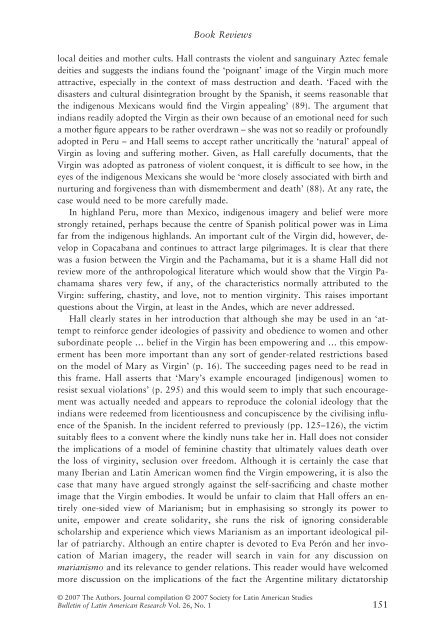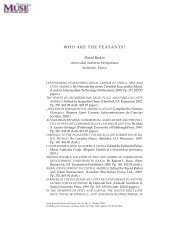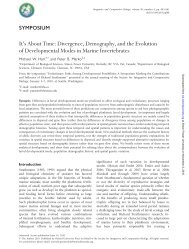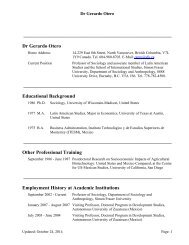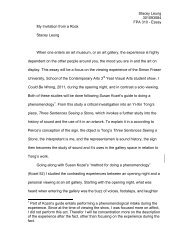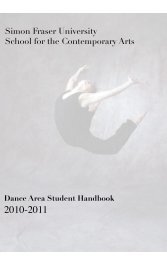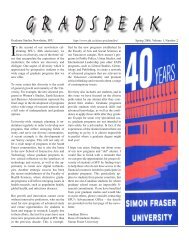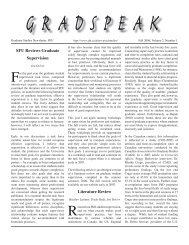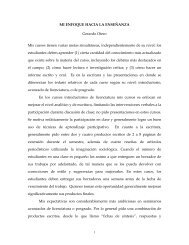Review of Mexico in Transition by Byron Crites
Review of Mexico in Transition by Byron Crites
Review of Mexico in Transition by Byron Crites
- TAGS
- transition
- byron
- crites
- cgi.sfu.ca
Create successful ePaper yourself
Turn your PDF publications into a flip-book with our unique Google optimized e-Paper software.
Book <strong>Review</strong>s<br />
local deities and mother cults. Hall contrasts the violent and sangu<strong>in</strong>ary Aztec female<br />
deities and suggests the <strong>in</strong>dians found the ‘ poignant ’ image <strong>of</strong> the Virg<strong>in</strong> much more<br />
attractive, especially <strong>in</strong> the context <strong>of</strong> mass destruction and death. ‘ Faced with the<br />
disasters and cultural dis<strong>in</strong>tegration brought <strong>by</strong> the Spanish, it seems reasonable that<br />
the <strong>in</strong>digenous Mexicans would fi nd the Virg<strong>in</strong> appeal<strong>in</strong>g ’ (89). The argument that<br />
<strong>in</strong>dians readily adopted the Virg<strong>in</strong> as their own because <strong>of</strong> an emotional need for such<br />
a mother fi gure appears to be rather overdrawn – she was not so readily or pr<strong>of</strong>oundly<br />
adopted <strong>in</strong> Peru – and Hall seems to accept rather uncritically the ‘ natural ’ appeal <strong>of</strong><br />
Virg<strong>in</strong> as lov<strong>in</strong>g and suffer<strong>in</strong>g mother. Given, as Hall carefully documents, that the<br />
Virg<strong>in</strong> was adopted as patroness <strong>of</strong> violent conquest, it is diffi cult to see how, <strong>in</strong> the<br />
eyes <strong>of</strong> the <strong>in</strong>digenous Mexicans she would be ‘ more closely associated with birth and<br />
nurtur<strong>in</strong>g and forgiveness than with dismemberment and death ’ (88). At any rate, the<br />
case would need to be more carefully made.<br />
In highland Peru, more than <strong>Mexico</strong>, <strong>in</strong>digenous imagery and belief were more<br />
strongly reta<strong>in</strong>ed, perhaps because the centre <strong>of</strong> Spanish political power was <strong>in</strong> Lima<br />
far from the <strong>in</strong>digenous highlands. An important cult <strong>of</strong> the Virg<strong>in</strong> did, however, develop<br />
<strong>in</strong> Copacabana and cont<strong>in</strong>ues to attract large pilgrimages. It is clear that there<br />
was a fusion between the Virg<strong>in</strong> and the Pachamama, but it is a shame Hall did not<br />
review more <strong>of</strong> the anthropological literature which would show that the Virg<strong>in</strong> Pachamama<br />
shares very few, if any, <strong>of</strong> the characteristics normally attributed to the<br />
Virg<strong>in</strong>: suffer<strong>in</strong>g, chastity, and love, not to mention virg<strong>in</strong>ity. This raises important<br />
questions about the Virg<strong>in</strong>, at least <strong>in</strong> the Andes, which are never addressed.<br />
Hall clearly states <strong>in</strong> her <strong>in</strong>troduction that although she may be used <strong>in</strong> an ‘ attempt<br />
to re<strong>in</strong>force gender ideologies <strong>of</strong> passivity and obedience to women and other<br />
subord<strong>in</strong>ate people … belief <strong>in</strong> the Virg<strong>in</strong> has been empower<strong>in</strong>g and … this empowerment<br />
has been more important than any sort <strong>of</strong> gender-related restrictions based<br />
on the model <strong>of</strong> Mary as Virg<strong>in</strong> ’ (p. 16). The succeed<strong>in</strong>g pages need to be read <strong>in</strong><br />
this frame. Hall asserts that ‘ Mary ’ s example encouraged [<strong>in</strong>digenous] women to<br />
resist sexual violations ’ (p. 295) and this would seem to imply that such encouragement<br />
was actually needed and appears to reproduce the colonial ideology that the<br />
<strong>in</strong>dians were redeemed from licentiousness and concupiscence <strong>by</strong> the civilis<strong>in</strong>g <strong>in</strong>fl uence<br />
<strong>of</strong> the Spanish. In the <strong>in</strong>cident referred to previously (pp. 125 – 126), the victim<br />
suitably fl ees to a convent where the k<strong>in</strong>dly nuns take her <strong>in</strong>. Hall does not consider<br />
the implications <strong>of</strong> a model <strong>of</strong> fem<strong>in</strong><strong>in</strong>e chastity that ultimately values death over<br />
the loss <strong>of</strong> virg<strong>in</strong>ity, seclusion over freedom. Although it is certa<strong>in</strong>ly the case that<br />
many Iberian and Lat<strong>in</strong> American women fi nd the Virg<strong>in</strong> empower<strong>in</strong>g, it is also the<br />
case that many have argued strongly aga<strong>in</strong>st the self-sacrifi c<strong>in</strong>g and chaste mother<br />
image that the Virg<strong>in</strong> embodies. It would be unfair to claim that Hall <strong>of</strong>fers an entirely<br />
one-sided view <strong>of</strong> Marianism; but <strong>in</strong> emphasis<strong>in</strong>g so strongly its power to<br />
unite, empower and create solidarity, she runs the risk <strong>of</strong> ignor<strong>in</strong>g considerable<br />
scholarship and experience which views Marianism as an important ideological pillar<br />
<strong>of</strong> patriarchy. Although an entire chapter is devoted to Eva Perón and her <strong>in</strong>vocation<br />
<strong>of</strong> Marian imagery, the reader will search <strong>in</strong> va<strong>in</strong> for any discussion on<br />
marianismo and its relevance to gender relations. This reader would have welcomed<br />
more discussion on the implications <strong>of</strong> the fact the Argent<strong>in</strong>e military dictatorship<br />
© 2007 The Authors. Journal compilation © 2007 Society for Lat<strong>in</strong> American Studies<br />
Bullet<strong>in</strong> <strong>of</strong> Lat<strong>in</strong> American Research Vol. 26, No. 1 151


